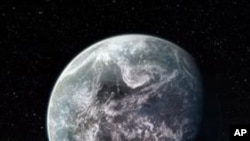European scientists say a small, rocky planet they've discovered orbiting a distant star is the smallest and most Earth-like planet ever found and might be capable of supporting life. The alien world is one of a record bounty of 50 exoplanets (planets outside our solar system), including 16 so-called "super-Earths" reported recently by European planet-hunters.
The rocky exoplanet orbits a parent star called "HD85512," located 35 light years from earth. The alien world is known by the suffix "b" after the star's name, and it is one of a class of exoplanets known as "super-Earths", rocky worlds no more than 10 times the mass of Earth. The new-found planet is about three-and-half times more massive than Earth.
Lisa Kaltenegger is with the Max Planck Institute for Astronomy in Germany and the Harvard-Smithsonian Center for Astrophysics in Massachusetts. “Up to about ten earth masses we actually think a planet can be rocky and, thus, could potentially be like our own planet," she said.
HD85512-b was discovered by Kaltenegger and a team of astronomers leading Europe’s High Accuracy Radial Velocity Planetary Search, or HARPS, Project.
Using the European South Observatory’s La Silla telescope in Chile, the HARPS planet hunters found planet "b" orbiting its parent star, a sun slightly smaller and cooler than our own, at a distance of 150 million kilometers [93.2 million miles]. That is almost the same distance between the Earth and the Sun, putting the alien planet within what astronomers call the “habitable zone.”
Astronomers believe a planet in the habitable zone is at just the right distance from its sun so that the planet's surface temperature is neither too hot nor too cold. They say conditions on planet "b" might permit the existence of liquid water, which is essential for supporting life.
The only way planetary scientists can determine whether life could exist on the planet is by reading in its light the chemical signatures of water and various gases associated with living organisms, such as oxygen, carbon dioxide, methane and ozone.
But astronomers say that because planet "b" is so far away, and its potential atmosphere is just a thin layer on a rocky sphere, current telescopes are not powerful enough to read any of its chemical signatures. For that, they say, they will need the European Extremely Large Telescope, or E-ELT. Construction on the one-billion dollar instrument begins next year. When it is completed, the 40-meter ground-based optical and near-infrared telescope will be the largest of its kind in the world, gathering 15 times more light than any existing telescope, including the Hubble Space Telescope.
E-ELT will contain an optical spectrograph that will analyze the contents of planet "b’s" and other exoplanets' atmosphere by dividing up incoming light, with each element in the planet's atmosphere reflecting a different color in the visible light spectrum.
Kaltenegger says it’s an exciting time for exoplanetary scientists. “We are really going out there in a way with our telescopes to discover brand new worlds. And we can do this within our own generation," she said.
So far, a total of more than 600 extra-solar planets have been discovered in nearby solar systems, 150 of them by the HARPS team alone. But most have been large gas giants orbiting stars well beyond the habitable zone. In 2007, the HARPS project found the only other super-Earth, a large rocky planet nearly eight times the mass of Earth, orbiting on the outer edge of its star's habitable zone.
The discovery of 50 new exo-planets, including HD85512-b, the smallest and most promising super-Earth yet, was presented Monday at a Wyoming conference on Extreme Solar Systems.
Scientists Discover Potentially Habitable Alien Planet









